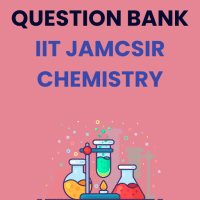Chemistry Exam > Chemistry Questions > The ethereal linkage (—C—O—...
Start Learning for Free
The ethereal linkage (—C—O—C—) is cleaved by:
- a)HBr
- b)HNO3
- c)Both (a) and (b)
- d)None
Correct answer is option 'A'. Can you explain this answer?
Most Upvoted Answer
The ethereal linkage (—C—O—C—) is cleaved by:a...
Also known as the ethereal connection or ethereal bond) is a metaphysical concept that describes a connection between two or more individuals or entities on a spiritual or energetic level.
According to this concept, the ethereal linkage is not dependent on physical proximity or communication, but rather on the alignment of energy, consciousness, or souls. It is believed to transcend time and space, allowing for a profound connection between individuals even when they are physically separated.
The ethereal linkage is often associated with deep emotional, mental, or spiritual connections. It is believed to enable individuals to understand and connect with each other on a profound level, often leading to a sense of unity, empathy, and shared experiences.
This concept is prevalent in various spiritual and esoteric traditions, such as certain forms of mysticism, New Age philosophies, and some belief systems focused on energy work or psychic abilities. It is often used to explain the bond between soulmates, twin flames, or spiritual allies.
The ethereal linkage is considered to be a powerful force that can facilitate growth, healing, and transformation. It is believed that individuals connected through this ethereal bond can support each other's spiritual journeys, provide guidance, and contribute to each other's personal and collective evolution.
However, it is important to note that the ethereal linkage is a concept that is not scientifically proven and may be interpreted differently by different individuals and belief systems. It is a subjective and personal experience that relies on intuition, spirituality, and metaphysical understandings.
According to this concept, the ethereal linkage is not dependent on physical proximity or communication, but rather on the alignment of energy, consciousness, or souls. It is believed to transcend time and space, allowing for a profound connection between individuals even when they are physically separated.
The ethereal linkage is often associated with deep emotional, mental, or spiritual connections. It is believed to enable individuals to understand and connect with each other on a profound level, often leading to a sense of unity, empathy, and shared experiences.
This concept is prevalent in various spiritual and esoteric traditions, such as certain forms of mysticism, New Age philosophies, and some belief systems focused on energy work or psychic abilities. It is often used to explain the bond between soulmates, twin flames, or spiritual allies.
The ethereal linkage is considered to be a powerful force that can facilitate growth, healing, and transformation. It is believed that individuals connected through this ethereal bond can support each other's spiritual journeys, provide guidance, and contribute to each other's personal and collective evolution.
However, it is important to note that the ethereal linkage is a concept that is not scientifically proven and may be interpreted differently by different individuals and belief systems. It is a subjective and personal experience that relies on intuition, spirituality, and metaphysical understandings.
Free Test
FREE
| Start Free Test |
Community Answer
The ethereal linkage (—C—O—C—) is cleaved by:a...
When hydrogen bromide (HBr) reacts with an ether, it can cleave the ether bond, resulting in the formation of an alcohol and an alkyl bromide. This reaction is known as ether cleavage or etherolysis.
The reaction mechanism involves the acid-catalyzed protonation of the ether oxygen, followed by the nucleophilic attack of bromide ion on the protonated ether. The resulting intermediate undergoes a rearrangement, and ultimately, the ether bond is broken.
Here's an example of the reaction between HBr and an ether, such as diethyl ether (C2H5OC2H5):
C2H5OC2H5 + HBr → C2H5OH + C2H5Br
In this reaction, diethyl ether reacts with hydrogen bromide to give ethanol (C2H5OH) and ethyl bromide (C2H5Br) as the products.
The reaction mechanism involves the acid-catalyzed protonation of the ether oxygen, followed by the nucleophilic attack of bromide ion on the protonated ether. The resulting intermediate undergoes a rearrangement, and ultimately, the ether bond is broken.
Here's an example of the reaction between HBr and an ether, such as diethyl ether (C2H5OC2H5):
C2H5OC2H5 + HBr → C2H5OH + C2H5Br
In this reaction, diethyl ether reacts with hydrogen bromide to give ethanol (C2H5OH) and ethyl bromide (C2H5Br) as the products.

|
Explore Courses for Chemistry exam
|

|
Question Description
The ethereal linkage (—C—O—C—) is cleaved by:a)HBrb)HNO3c)Both (a) and (b)d)NoneCorrect answer is option 'A'. Can you explain this answer? for Chemistry 2025 is part of Chemistry preparation. The Question and answers have been prepared according to the Chemistry exam syllabus. Information about The ethereal linkage (—C—O—C—) is cleaved by:a)HBrb)HNO3c)Both (a) and (b)d)NoneCorrect answer is option 'A'. Can you explain this answer? covers all topics & solutions for Chemistry 2025 Exam. Find important definitions, questions, meanings, examples, exercises and tests below for The ethereal linkage (—C—O—C—) is cleaved by:a)HBrb)HNO3c)Both (a) and (b)d)NoneCorrect answer is option 'A'. Can you explain this answer?.
The ethereal linkage (—C—O—C—) is cleaved by:a)HBrb)HNO3c)Both (a) and (b)d)NoneCorrect answer is option 'A'. Can you explain this answer? for Chemistry 2025 is part of Chemistry preparation. The Question and answers have been prepared according to the Chemistry exam syllabus. Information about The ethereal linkage (—C—O—C—) is cleaved by:a)HBrb)HNO3c)Both (a) and (b)d)NoneCorrect answer is option 'A'. Can you explain this answer? covers all topics & solutions for Chemistry 2025 Exam. Find important definitions, questions, meanings, examples, exercises and tests below for The ethereal linkage (—C—O—C—) is cleaved by:a)HBrb)HNO3c)Both (a) and (b)d)NoneCorrect answer is option 'A'. Can you explain this answer?.
Solutions for The ethereal linkage (—C—O—C—) is cleaved by:a)HBrb)HNO3c)Both (a) and (b)d)NoneCorrect answer is option 'A'. Can you explain this answer? in English & in Hindi are available as part of our courses for Chemistry.
Download more important topics, notes, lectures and mock test series for Chemistry Exam by signing up for free.
Here you can find the meaning of The ethereal linkage (—C—O—C—) is cleaved by:a)HBrb)HNO3c)Both (a) and (b)d)NoneCorrect answer is option 'A'. Can you explain this answer? defined & explained in the simplest way possible. Besides giving the explanation of
The ethereal linkage (—C—O—C—) is cleaved by:a)HBrb)HNO3c)Both (a) and (b)d)NoneCorrect answer is option 'A'. Can you explain this answer?, a detailed solution for The ethereal linkage (—C—O—C—) is cleaved by:a)HBrb)HNO3c)Both (a) and (b)d)NoneCorrect answer is option 'A'. Can you explain this answer? has been provided alongside types of The ethereal linkage (—C—O—C—) is cleaved by:a)HBrb)HNO3c)Both (a) and (b)d)NoneCorrect answer is option 'A'. Can you explain this answer? theory, EduRev gives you an
ample number of questions to practice The ethereal linkage (—C—O—C—) is cleaved by:a)HBrb)HNO3c)Both (a) and (b)d)NoneCorrect answer is option 'A'. Can you explain this answer? tests, examples and also practice Chemistry tests.

|
Explore Courses for Chemistry exam
|

|
Signup for Free!
Signup to see your scores go up within 7 days! Learn & Practice with 1000+ FREE Notes, Videos & Tests.


















